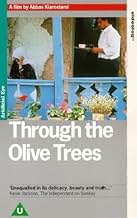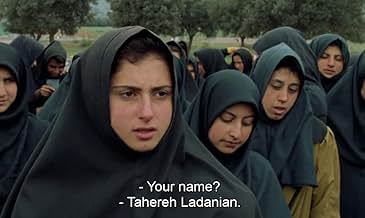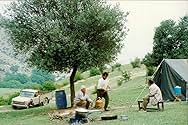VALUTAZIONE IMDb
7,7/10
11.132
LA TUA VALUTAZIONE
Una rappresentazione della relazione fuori campo tra una coppia di attori che interpretano gli sposi novelli.Una rappresentazione della relazione fuori campo tra una coppia di attori che interpretano gli sposi novelli.Una rappresentazione della relazione fuori campo tra una coppia di attori che interpretano gli sposi novelli.
- Regia
- Sceneggiatura
- Star
- Premi
- 5 vittorie e 6 candidature totali
Ostadvali Babaei
- Teacher
- (as Astadouli Babani)
Nosrat Bagheri
- Achiz
- (as Nasret Betri)
Khodabakhsh Defaei
- Teacher
- (as Kheda Barech Defai)
Hossein Jafarian
- Hossein
- (non citato nei titoli originali)
Jafar Panahi
- Panahi
- (non citato nei titoli originali)
Recensioni in evidenza
First thing: this is the third part in a trilogy. You really need to see "Where is the Friend's House" & "And Life Goes On" first if you want to fully understand this. In short, this is a film about a man making a film of his own journey in search of actors in a film he made earlier. Once you know that, it's not in the least slow or simple, it's a hall of mirrors, as another commentator put it. Frames within frames within frames.
Second thing: Jean-Luc Godard praised Kiarostami's early films, but then felt he'd become too influenced by the international art movie tradition. I don't know if this is a film he liked or disliked, but it sure has a lot of Godard's influence in it - from the director interviewing sundry characters through the conflation of documentary and fiction elements to the use of music, it's like Godard crossed with Satyajit Ray. Not that that's a bad thing.
I don't know if Kiarostami is as original or as striking as some maintain - in many ways this is "Day for Night" transplanted to the Iranian countryside - but it's very watchable, often very funny and the landscape is beautiful.
There also seems to be (in the Iranian context) a subversive subtext to these films. Tradition is held up as hidebound and stupid (the adults in "Where is the Friend's House", the grandmother in this film) while the young are seen improvising their own lives and creating hope in the face of catastrophe. I can't imagine that's too popular with the mullahs, and indeed it seems that Kiarostami has been unable to get a film released in Iran in a decade.
Well worth a view, and it may even inspire you to get out into the world with a digital video camera, but do see the other films (and probably also "Homework") first.
Second thing: Jean-Luc Godard praised Kiarostami's early films, but then felt he'd become too influenced by the international art movie tradition. I don't know if this is a film he liked or disliked, but it sure has a lot of Godard's influence in it - from the director interviewing sundry characters through the conflation of documentary and fiction elements to the use of music, it's like Godard crossed with Satyajit Ray. Not that that's a bad thing.
I don't know if Kiarostami is as original or as striking as some maintain - in many ways this is "Day for Night" transplanted to the Iranian countryside - but it's very watchable, often very funny and the landscape is beautiful.
There also seems to be (in the Iranian context) a subversive subtext to these films. Tradition is held up as hidebound and stupid (the adults in "Where is the Friend's House", the grandmother in this film) while the young are seen improvising their own lives and creating hope in the face of catastrophe. I can't imagine that's too popular with the mullahs, and indeed it seems that Kiarostami has been unable to get a film released in Iran in a decade.
Well worth a view, and it may even inspire you to get out into the world with a digital video camera, but do see the other films (and probably also "Homework") first.
This epoch-making poem opens with a film crew trying to cast for a movie in a provincial village, in the aftermath of A DEVASTATING EARTHQUAKE which has claimed many, many lives. We then are shown that the remaining people are trying to rebuild their lives, picking up bits and pieces of the past, but with an eye to the future.example of these people are the boy and the girl who are selected to play the protagonists of the melodrama to be made. The crew's interest interest in these people is limited to their role and usefulness for director's vision of the film, and no more. But-and this is a crucial BUT-the boy and the girl have their own agenda, and don't care very much for the screenplay dictated by the director (for instance repeated takes of the tea-serving scene): The girl wants to wear colorful and jolly dress, and the boy wants to be able to love her. Eventually, the boy follws the girl into the magnificent ending shot of the expanse of the olive groves, and into the ubncertain but potentially hopeful future. Will life, love and color be able to vanquish darkness and death? Will the boy and the girl find the courage and and power to fire the crew, the director, the casting agent , down to the ticket-vendor and become subjects of their own life and destiny? ... This is to be continued.........
This is the art movie in its essence. Every single minute of this movie is complexly detailed. It was considered by the critics a masterpiece but it could not be nominated for the Academy Awards in the 'Foreign Language Category' because of political problems between Iran and USA at the time (but in 99 'Children of Heaven' was nominated).
It was written by Abbas Kiarostama, who also wrote 'The White Balloon' (another great film) and 'Taste of Cherry' (not so good, although it won the Cannes Palm D'or).
This is a must see for any fan of artfilms. Simply fantastic, amazing and everything else, this movie is a 'sea of creativity'.
It was written by Abbas Kiarostama, who also wrote 'The White Balloon' (another great film) and 'Taste of Cherry' (not so good, although it won the Cannes Palm D'or).
This is a must see for any fan of artfilms. Simply fantastic, amazing and everything else, this movie is a 'sea of creativity'.
I saw the movie while on vacation in Sweden. Just clicking through TV channels, I stopped on this movie accidentally, initially not paying much attention to it. But the images started to attract me, finally they got hold of me. The realism of everyday life with some strange air of poetic aura was fascinating. The action just floats like a river, no big happenings but pictures are dense, close to skin, close to feelings. The people dreams pour out into daily life. The shaky balance between reality and a dream culminates in the last sequence and we hope for an answer, which is not disclosed but we are left to search it in our imagination and in our dreams evoked by this wonderful movie. Maybe longing for an answer is all what is possible.
I'd just like to disagree with those who suggest this film may not be accessible to people who have not seen the first two films in the trilogy. I haven't, but have not been as bewitched by a film since I saw Aggelopoulos' Travelling Players for the first time. My heart responded, the hairs on the back of my neck responded, my being responded. No matter if my brain wasn't fully au fait with what came before. Superb doesn't begin to cover it. How he captured these (non)performances from his actors is beyond me: perhaps, unfamiliar with the conventions of film-making, they were uniquely equipped to sidestep them.
Michael
Michael
Lo sapevi?
- QuizThe first film in which Abbas Kiarostami has hired a professional actor (Mohamad Ali Keshavarz who plays the director of the film-within-the-film).
- ConnessioniFeatured in Cinema Iran (2005)
I più visti
Accedi per valutare e creare un elenco di titoli salvati per ottenere consigli personalizzati
- How long is Through the Olive Trees?Powered by Alexa
Dettagli
Botteghino
- Lordo Stati Uniti e Canada
- 40.300 USD
Contribuisci a questa pagina
Suggerisci una modifica o aggiungi i contenuti mancanti

Divario superiore
By what name was Sotto gli ulivi (1994) officially released in India in English?
Rispondi









